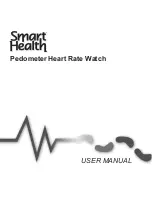
truenordic.com
TN2300000501 • 3
WHAT IS AN AVERAGE HEART RATE?
While taking a reading your pulse will appear on your true pulse™ with an icon of a heart. Your pulse naturally
fluctuates as your heart reacts to external and internal stimuli. Your average heart rate is an average of your pulse over
a set period of time and displays as beats per minute (BPM). Your average resting heart rate is likely to be between
60 and 100 beats per minute. If you are a well-conditioned athlete it may be closer to between 40 and 60 beats per
minute. Your maximum heart rate should be approximately 220 minus your age. During or after exercises your heart
rate should reach 60 - 80 % of this maximum.
If you are 40 then your maximum heart rate should be 180 and during exercise it is likely to be 108 - 144 BPM.
MEASURE YOUR HRV - HEART RATE VARIABILITY
HRV stands for heart rate variability and shows the variation in the time intervals between your heartbeats. It provides
a good indication of your cardiovascular fitness and health in general.
Your true pulse™ takes two readings (an electrocardiogram and a photoplethysmograph) and uses them to calculate
your HRV. A small number means that there is less variation in your pulse and your body may be experiencing, or have
more difficulty reacting to factors which cause stress. A larger number means a greater variation and is an indicator of
good cardiovascular fitness and the ability for your body to handle internal and external stress.
The two best times of day to check your HRV are 30 minutes after waking up or in a quiet period before you go
to sleep. Avoid using the sauna, exercising, smoking or stimulating your metabolism with food, or hot, sugary or
caffeinated drinks for at least 30 minutes prior to completing an HRV reading.
Your true pulse™ should be worn on the top of your left wrist, like a watch. The silver coloured sensor should be on
the side closest to your thumb. The band should sit comfortably, just below your wrist bone.
Sit at a table and rest your arm comfortably on the table. Put both feet flat on the floor, relax and breath normally.
Tap the sensor on the front of your true pulse™ to select HRV mode
(the icon depicts a line graph).
Hold your finger on the sensor to begin measuring your HRV.
It will take up to three minutes to complete your HRV reading.
During the reading you will see a status bar and an indication of your heart’s beats per minute (BPM).
Once the reading is completed your true pulse™ will display your HRV and “body age” followed by a fatigue and stress
measurement. The lower the numbers are the better when it comes to measuring your body age, fatigue and stress.
Sync your true pulse™ with the Nyftii app. Tap on “Bio” or “Trend” in the app to see your latest HRV readings.
Your true pulse™ can be set to automatically measure your heart rate at regular intervals. This can be turned on in
“Settings” / “Heart Rate Measurement” / “Auto Measurement”.
CALIBRATE AND CHECK YOUR PWTT - PULSE WAVE TRANSIT TIME - BLOOD PRESSURE
PWTT stands for pulse wave transit time and is an indicator of blood pressure.
The correlation between blood pressure and PWTT varies from person to person based on height, weight, age and
other factors. To set the base point for your PWTT readings as an indicator of your blood pressure you will need to
enter a one off reading taken with a traditional blood pressure monitor and enter the details into the Nyftii app. If you
experience hypertension (high blood pressure) you must complete this calibration step before using your true pulse™
to monitor your blood pressure.
Complete the calibration:
• Use a traditional blood pressure monitor normally available at your local health clinic, pharmacy or GP to check
your systolic pressure, diastolic pressure and pulse.
• In the Nyftii app go to “Settings” / “PWTT” / “Calibration” and enter your measurements.
























